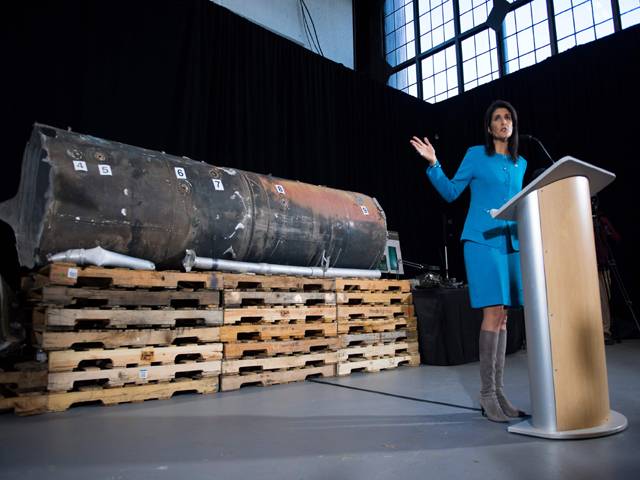WASHINGTON - US ambassador to the United Nations Nikki Haley presented “concrete” evidence Thursday that a ballistic missile fired by Huthi rebels in Yemen at Saudi Arabia last month was Iranian-made, a charge Tehran immediately denied.
Haley accused Tehran of a “blatant violation” of UN Security Council obligations designed to reign in its missile activity, further stepping up the rhetoric towards Iran which Washington accuses of going against the spirit of a historic nuclear accord.
Standing in a warehouse at a Washington military base in front of pieces of a missile, Haley said Iranian fingerprints were all over the weapon that was fired at Riyadh’s airport on November 4. “It was made in Iran then sent to Huthi militants in Yemen,” Haley said. “From there it was fired at a civilian airport with the potential to kill hundreds of innocent civilians in Saudi Arabia.”
Alireza Miryousefi, spokesman at Iran’s mission to the United Nations, said Tehran “categorically” rejects the US claims. “This purportedly evidence, put on public display today, is as much fabricated as the one presented on some other occasions earlier,” he said.
The Iranian mission said the accusations leveled by Haley were intended to divert attention from the devastating war in Yemen being led by Saudi Arabia, a key US ally.
Haley has called on the UN Security Council to take a tougher stance toward Iran, accusing Tehran of making illegal arms deals in Yemen, Lebanon and Syria.
A confidential report to the council says UN officials had examined debris from missiles fired at Saudi Arabia which pointed to a “common origin” but there was no firm conclusion as to whether they came from an Iranian supplier.
Haley said the missile was an Iranian Qiam-class short-range ballistic missile and pointed to valves that she said proved its origin. The Qiam-1 is based on a modified Scud design.
“Today’s revelations proved yet again that Iran’s dangerous presence in the Middle East is only growing despite their attempts to deceive the world,” Israel’s ambassador to the UN Danny Danon said in a statement. “The threat of Iranian missiles stretches from the Persian Gulf, through Yemen, Syria and all the way to Lebanon and Gaza.”
The report from UN Secretary-General Antonio Guterres, which was obtained by AFP, said the officials were still analyzing the information.
A separate team of UN experts who inspected the missile fragments during a visit to Riyadh last month found a possible link to an Iranian manufacturer, the Shahid Bagheri Industrial Group, which is on the UN sanctions blacklist.
The experts, who report to the sanctions committee, found a component marked by a logo similar to that of the banned group, which is a subsidiary of the Iranian Aerospace Industries Organization.
In his report, Guterres said officials had seen the logo but that they were still analyzing the information.
Behnam Ben Taleblu, senior Iran analyst for the Foundation for Defense of Democracies, told AFP that Iran’s apparent willingness to risk transferring missiles to the Huthis indicates that the Yemeni theater “may not be as peripheral to Tehran as previously assumed.”
“Bleeding Saudi Arabia of money and men is a clear goal for Iran as it continues its war in Yemen,” he said in an email.
Aside from leading a military campaign in Yemen, Saudi Arabia has deployed expensive Patriot missiles at home to guard against incoming rockets.
Recent Iranian missile launches have triggered US sanctions and accusations they violate the spirit of a 2015 nuclear deal between Tehran and major powers.
“This is not just about the nuclear program. This is about everything else they’re doing... Iran believes they have been given a pass,” Haley charged.
A Saudi-led coalition fighting rebels in Yemen imposed a blockade of Yemen’s air and sea ports and borders after the missile was fired at Riyadh, citing concerns that weapons were being smuggled into Yemen.






